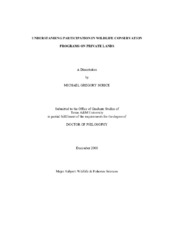| dc.contributor.advisor | Ditton, Robert B. | |
| dc.creator | Sorice, Michael G. | |
| dc.date.accessioned | 2010-01-14T23:54:43Z | |
| dc.date.accessioned | 2010-01-16T00:00:11Z | |
| dc.date.available | 2010-01-14T23:54:43Z | |
| dc.date.available | 2010-01-16T00:00:11Z | |
| dc.date.created | 2008-12 | |
| dc.date.issued | 2010-01-14 | |
| dc.identifier.uri | https://hdl.handle.net/1969.1/ETD-TAMU-2008-12-190 | |
| dc.description.abstract | One major lesson derived from the implementation of the Endangered Species
Act (ESA) over the past 30 years is that direct regulation is not the only nor the optimal
way to protect endangered species on working lands because of an undue burden
imposed on private landowners. The role of a voluntary conservation program is to
rearrange incentives so that society bears the cost rather than the landowner. Employing
a survey research methodology, I used theories of reasoned action and random choice to
explore landowners? stated preferences for conservation programs.
I found landowners? stated interest in compensation programs to be moderate at
best. For those willing to consider programs involving endangered species, associating
land management requirements for species conservation with direct benefits to the
landowner is important, but perhaps not as important as ensuring that the program
provides adequate financial incentives, consideration of the term of the program, and a
level of certainty regarding the landowner?s future obligations under the ESA.
Landowners are not a homogenous group. I identified two classes of landowners
according to preferences for program structure. One group was highly sensitive to
program structure, aside from financial incentives, while the other was likely to
participate if adequately compensated with financial and technical assistance. These
differences related to opinions on endangered species protection and dependence on their
land for income. Voluntary incentive programs increasingly are a popular tool to maintain and
enhance conservation; however, these programs are only successful insofar as
landowners choose to enroll. This research demonstrates that improving recovery efforts
on private lands requires program administrators to have a more complete understanding
of landowners? views on endangered species and conservation programs in general, as
well as their motivations for owning and operating their land. By doing so, programs
with broader appeal and greater efficacy can be designed and implemented. | en |
| dc.format.mimetype | application/pdf | |
| dc.language.iso | en_US | |
| dc.subject | endangered species | en |
| dc.subject | human dimensions | en |
| dc.subject | incentive programs | en |
| dc.subject | private lands | en |
| dc.subject | landowners | en |
| dc.subject | decision making | en |
| dc.subject | conservation | en |
| dc.subject | endangered species act | en |
| dc.subject | black-capped vireo | en |
| dc.subject | golden-cheeked warbler | en |
| dc.subject | ranchers | en |
| dc.subject | theory of reasoned action | en |
| dc.subject | stated preference choice model | en |
| dc.subject | choice experiment | en |
| dc.subject | biodiversity | en |
| dc.subject | wildlife management | en |
| dc.subject | non-game wildlife | en |
| dc.subject | texas | en |
| dc.subject | fort hood | en |
| dc.subject | recovery credit system | en |
| dc.title | Understanding Participation in Wildlife Conservation Programs on Private Lands | en |
| dc.type | Book | en |
| dc.type | Thesis | en |
| thesis.degree.department | Wildlife and Fisheries Sciences | en |
| thesis.degree.discipline | Wildlife and Fisheries Sciences | en |
| thesis.degree.grantor | Texas A&M University | en |
| thesis.degree.name | Doctor of Philosophy | en |
| thesis.degree.level | Doctoral | en |
| dc.contributor.committeeMember | Conner, Richard | |
| dc.contributor.committeeMember | Haider, Wolfgang | |
| dc.contributor.committeeMember | Sell, Jane | |
| dc.contributor.committeeMember | Wilkins, Neal | |
| dc.type.genre | Electronic Dissertation | en |


